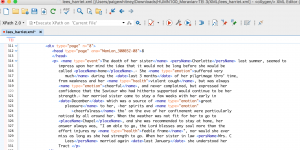Marking up my transcription was actually an integral aspect to my understanding of the text. I feel as if being able to analyze the text through breaking down different aspects of the words was really helpful in that it made me feel closer to the actual words and meanings of the text itself. Instead of just reading every small word individually, I was able to see how every word shaped the overall meaning of the text due to tagging.
I feel as if the Bethlehem memoirs in specific were important with regards to the aspect of understanding how the memoirs interrelate. Our memoirs were different from the other memoirs in that we had several different authors all from the same relative time period, rather than just one single memoir. This method of marking up was also unique with our Bethlehem memoirs in that we had varying accounts of mentioning the word “Lord”, “Savior”, or ”Jesus”. To remain consistent throughout, we decided as a group to tag any occurrences of the Holy Spirit as a person. We had to make some cuts on what should be considered tangible, and what should not be considered taggable. As Pierazzo says, “informed choices need to be made on what to include because it is relevant and what can be safely omitted” (Pierazzo 467).

Collaborating with the rest of my editorial board (group) also heavily influenced my perspective on the memoirs as a whole. I feel as if when it was just me editing my own memoir, I had a single perspective on which words should be tagged. When I gave it to the rest of my group to revise , they pointed out aspects of my memoir that I hadn’t previously considered taggable, and thus I was able to get a more full sense of my memoir.

I really enjoyed using TEI with my memoir. I think Pierazzo summarized it best when she said “to all intents and purposes there is no limit to the information one can add to a text—apart, that is, from the limits of imagination” (Pierazzo 466). Using technology to actually be able to analyze all accounts of different aspects of these memoirs was an invaluable opportunity, and is a “much less limiting” medium to engage in analysis. (Pierazzo 464).
I also believed that learning how to use this software gave me a strong insight on how to apply to this to other literature that I may encounter. I have gotten a much firmer understanding of html and how computer processes and systems work, so I feel like I have a more diverse approach to the digital humanities now. I now have a knack for transcription AND a knack for using the technology associated with analyzing those said transcribed texts.

Overall, I believe that I have a much more complete and wholistic grasp on the Bethlehem memoirs, but specifically that of Anna Elizabeth Rauch. I now understand more of why she did what she did because I tagged different aspects of her emotions and her health. When I had read the memoir previously, it seemed a little dry, and I was confused about the sequence of events that occurred and why they happened. Now I know how Anna’s emotions and state of mind shaped her journey working in Jamaica on the Mesopotamia plantation.
I am a sophomore at Bucknell University, majoring in Mathematical Economics and minoring in Computer Science.



 TEI-complaint XML markup had me paying attention to every single word once again. However, while this new view allowed me to closely look at every word, I also had to pay attention to the larger context in which the words were placed. By paying attention to the larger context in which the words were places, I was able to interpret what I thought Joseph Lingard was saying, while also trying to correctly tag the transcription.
TEI-complaint XML markup had me paying attention to every single word once again. However, while this new view allowed me to closely look at every word, I also had to pay attention to the larger context in which the words were placed. By paying attention to the larger context in which the words were places, I was able to interpret what I thought Joseph Lingard was saying, while also trying to correctly tag the transcription.